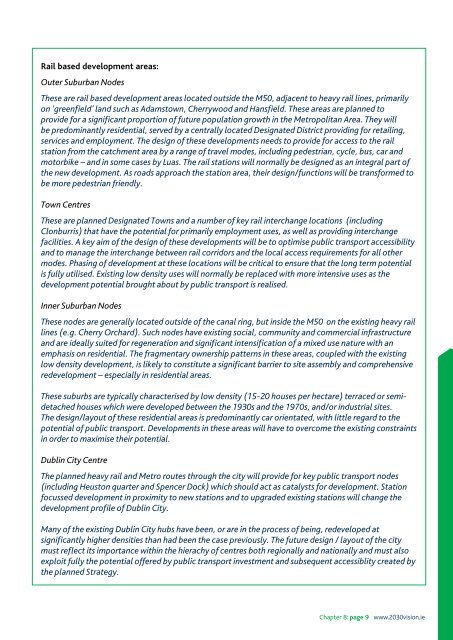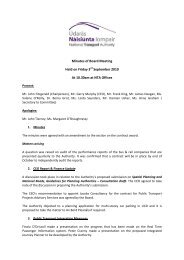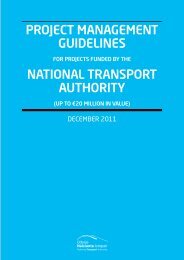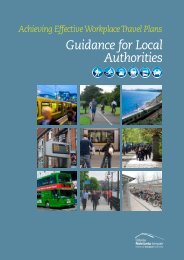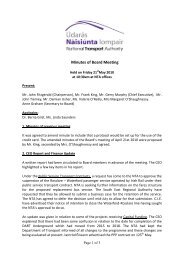Greater Dublin Area Draft Transport Strategy 2011-2030
Greater Dublin Area Draft Transport Strategy 2011-2030
Greater Dublin Area Draft Transport Strategy 2011-2030
- No tags were found...
Create successful ePaper yourself
Turn your PDF publications into a flip-book with our unique Google optimized e-Paper software.
Rail based development areas:Outer Suburban NodesThese are rail based development areas located outside the M50, adjacent to heavy rail lines, primarilyon ‘greenfield’ land such as Adamstown, Cherrywood and Hansfield. These areas are planned toprovide for a significant proportion of future population growth in the Metropolitan <strong>Area</strong>. They willbe predominantly residential, served by a centrally located Designated District providing for retailing,services and employment. The design of these developments needs to provide for access to the railstation from the catchment area by a range of travel modes, including pedestrian, cycle, bus, car andmotorbike – and in some cases by Luas. The rail stations will normally be designed as an integral part ofthe new development. As roads approach the station area, their design/functions will be transformed tobe more pedestrian friendly.Town CentresThese are planned Designated Towns and a number of key rail interchange locations (includingClonburris) that have the potential for primarily employment uses, as well as providing interchangefacilities. A key aim of the design of these developments will be to optimise public transport accessibilityand to manage the interchange between rail corridors and the local access requirements for all othermodes. Phasing of development at these locations will be critical to ensure that the long term potentialis fully utilised. Existing low density uses will normally be replaced with more intensive uses as thedevelopment potential brought about by public transport is realised.Inner Suburban NodesThese nodes are generally located outside of the canal ring, but inside the M50 on the existing heavy raillines (e.g. Cherry Orchard). Such nodes have existing social, community and commercial infrastructureand are ideally suited for regeneration and significant intensification of a mixed use nature with anemphasis on residential. The fragmentary ownership patterns in these areas, coupled with the existinglow density development, is likely to constitute a significant barrier to site assembly and comprehensiveredevelopment – especially in residential areas.These suburbs are typically characterised by low density (15-20 houses per hectare) terraced or semidetachedhouses which were developed between the 1930s and the 1970s, and/or industrial sites.The design/layout of these residential areas is predominantly car orientated, with little regard to thepotential of public transport. Developments in these areas will have to overcome the existing constraintsin order to maximise their potential.<strong>Dublin</strong> City CentreThe planned heavy rail and Metro routes through the city will provide for key public transport nodes(including Heuston quarter and Spencer Dock) which should act as catalysts for development. Stationfocussed development in proximity to new stations and to upgraded existing stations will change thedevelopment profile of <strong>Dublin</strong> City.Many of the existing <strong>Dublin</strong> City hubs have been, or are in the process of being, redeveloped atsignificantly higher densities than had been the case previously. The future design / layout of the citymust reflect its importance within the hierachy of centres both regionally and nationally and must alsoexploit fully the potential offered by public transport investment and subsequent accessiblity created bythe planned <strong>Strategy</strong>.Chapter 8: page 9 www.<strong>2030</strong>vision.ie


